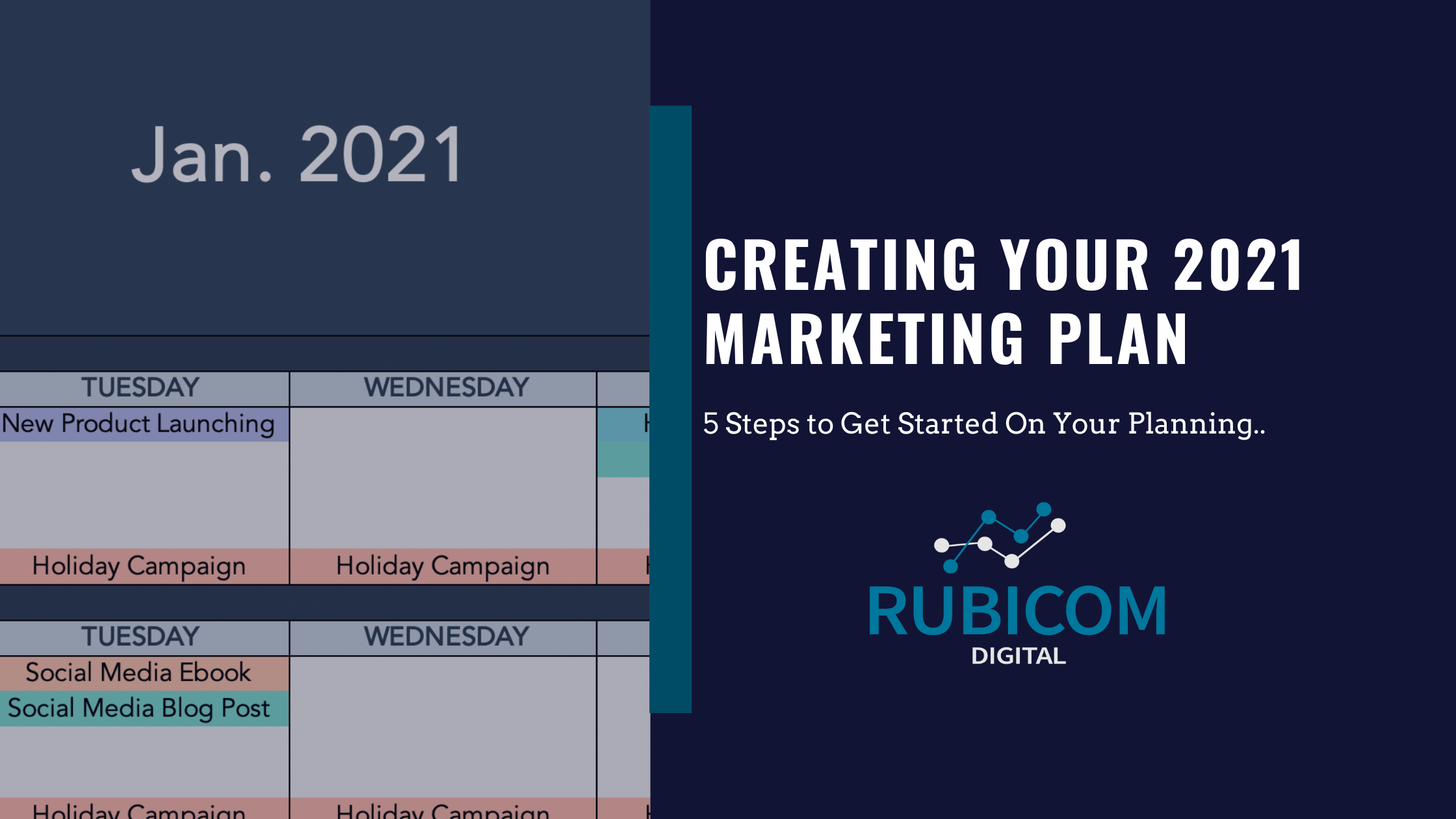Creating Your 2021 Marketing Plan for Long Term Success
It’s that time of the year again where you’re starting to wrap up your 2020 pipeline and create your 2021 marketing plan. Your marketing plan should take into account what worked well for you over the past year, and which areas have some room for improvement.
Your marketing plan is by no means a way to drive immediate sales, but rather set up your business for long term success by adding an additional source of organic leads that complement your organizations’ sales efforts.
Business leaders are often turned off by that statement because they want sales immediately, marketing just doesn’t work that way.
In truth, if you executed on your marketing strategy effectively in the previous year, you’ll probably see deals continue to come through during the following year(s); Be sure to attribute them accurately. This is attractive because you’re reaping benefits from prior campaigns and marketing plans.
In other words, creating your 2021 marketing plan will surely bring you leads in 2021, but we’re also looking to 2022 and beyond already.
What is a Marketing Plan?
Your marketing plan should outline your marketing strategy in order to clearly measure objectives and improve upon your overall marketing practices.
Keep in mind that this plan doesn’t need to be an elaborate, 10-page document that the entire company needs a briefing on; It can be as simple as 1-page that highlights everything you want to accomplish for the year.
Now let’s dive into 5 steps to help you to build that marketing plan.
- Define Your Objectives
Objectives need to be clearly measurable in order to execute on a strategy that helps you achieve your goals. Here’s what we mean.
Bad objective: Grow number of marketing leads in 2021
Good objective: Grow number of marketing leads by 20% in 2021
Bad objective: get more leads
Good objective: obtain 3 more leads per month compared to the prior year; With a lead being defined as a prospect interested in purchasing within the next 12 months.
The main difference here is that we’re tying specific numbers and a metric behind what the objective is. By understanding that you need to grow leads by 20%, you’re forced to analyze:
- Past performance (the number of leads in 2020)
- Which channels drove those leads (email, SEO, digital advertising, etc.)
- How to better perform within those channels (or even add an additional channel)
The first order of business within your 2021 marketing plan is defining your objectives. Start with 3 – 5 so that you don’t overwhelm the remainder of the planning, and then build on it from there if need be.
A ‘less is more’ approach is also effective because it provides only critical goals that will drive the best results for your business.
- Analyze Past Performance
After the objectives are defined, you’ll want to analyze past performance to see what has served you well, where there’s potential for improvement, and if there are any missing aspects that you’ll want to add in the future.
What does past performance look like? Break down each channel of your marketing strategy and compare the results against your previous objectives. Examples include:
Email Marketing:
- How many emails were delivered per month?
- What were the open rates?
- How many contacts did your list grow by?
- How many leads did email attribute to your pipeline?
Search Engine Optimization:
- What was your monthly organic traffic?
- How many keywords is your organization ranking for?
- What is your average position within search engines for your top keywords?
- How many leads did SEO attribute to your organization?
Digital Advertising:
- How much money did you spend in the prior year on digital ads?
- Compared to how much you spent, how much revenue did the advertising drive?
- What did your ads look like when compared to your competitors?
You’ll notice that each of these questions require you to attribute sales pipeline to each marketing channel. To do this you need to fully understand marketing attribution and how to track it.
- Finalize The Marketing Channels That You’ll Use
According to Disruptive Advertising, there are 6 main marketing channels that you should be using. Those channels include:
- Pay-Per-Click Marketing (digital advertising)
- Social Media
- Email Marketing
- Your Website
- Content Marketing & SEO
- Word of Mouth Marketing
The goal in these channels is to answer customer questions, show how your solution fills in a gap they’re experiencing, and make it easy to reach out if interested. Within these channels, focus less on selling and more on informing.
Ideally, these channels will all leverage automation and flow together in order to provide a consistent user-experience for your target audience, and a greater return on investment for your business.
Be sure to track data metrics and continue to optimize each channel to get the most effective outcomes for the money that you’re putting into them.
Also note that there are other channels to distribute your marketing content on, but the ones discussed here will be your foundational pieces going into the next year or two.
*Disclaimer, podcasting and text message marketing are growing increasingly popular.
- Outline Optimizations For Each Channel
Once you’ve analyzed your past performance, you’ll be able to better understand where you need to improve to reach your newly determined objectives in the year ahead.
Whether it’s tweaking the copy of your outbound email practices, or spending more on digital ads that produces the most revenue, there are always optimizations to be made.
Digital marketing, much like every other aspect of an organization, is never finalized and is rather in constant need of adjustments to improve.
To get you brainstorming, some optimizations that can be made include but aren’t limited to:
- Creating more content similar to what engages your target audience
- Refining your target audience
- Further leveraging social media to engage your audience
- Cutting down on the number of emails sent
- Hiring an SEO consultant
- Pumping more or less $$$ into digital ads
Because there are so many different channels within your marketing plan, be sure to leverage professionals that specialize in each one for the greatest results. Oftentimes, that’s a combination of leveraging internal resources in addition to professional marketing consultants to complement your team and their efforts.
Regardless of where you choose to leverage an external resource, a set of eyes that is entrenched in the day-to-day like you are can be beneficial.
- Begin Executing on Your Marketing Strategy
With clearly defined objectives, data on past performance, marketing channels for distribution determined, and optimizations in place it’s time to start putting your 2021 marketing plan into action.
As Ben Franklin stated, “If you fail to plan, you are planning to fail.”
One of the best planning tools are the content and execution calendars. These tools allow you to:
- Track each task that needs to be accomplished on a given week
- Assign tasks to team members with deadlines for completion
- Plan for the months ahead so that your campaigns align with each other
- Remove the guesswork on what needs to be accomplished throughout the year
Share these calendars across your teams and manage them weekly in order to make sure you’re meeting your objectives.
To further improve your strategy, leverage marketing automation wherever possible, and ensure that you’re creating high quality content that will engage and inform your target audience.
Continuous Optimization
Although you’ve gone through each step to create a plan for the year ahead, you’re not done yet.
“Everyone has a plan until they get punched in the mouth.” – Mike Tyson
Expect that each aspect of your strategy will not work as you initially anticipated, and therefore be ready to make continuous improvements to your marketing strategy.
Understanding that although everything may not work the way you’d like, having the agility to improve your plan will allow you to make changes and put your plan in a better position for success. This is true whether you’re gameplanning for a rival football team, or competing with your 2021 marketing plan.
Some realizations that inform you that the strategy needs to adapt include but aren’t limited to:
- Your posts aren’t driving enhanced engagement from the prior year
- Email engagement is decreasing
- Your website is seeing a slowdown in traffic
- Digital ads aren’t generating the return you’d expect
Leverage what the data is telling you and be open to ideas that will help improve your strategy.
Let us know how your plan is coming along or if you’d like a second set of eyes on your current efforts!

Gary McConnell Co-founded Rubicom Digital in 2019 with a goal of providing digital marketing consulting services in the B2B space.
Gary continues to serve as the Marketing Director of a Data Center-focused IT Provider, VirtuIT Systems.


1 thought on “Creating Your 2021 Marketing Plan: 5 Steps”
Comments are closed.